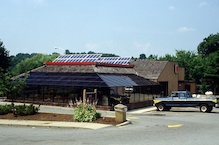
Today, Bloomberg NEF (BNEF) published its annual long-term analysis of the future of the global electricity system – New Energy Outlook (NEO) 2018. The 150-page report draws on detailed research by more than 65 analysts around the world, including sophisticated modeling of power systems country-by-country, and of the evolving cost dynamics of different technologies.
This year’s outlook is the first to highlight the impact falling battery costs will have on the electricity mix over the coming decades. BNEF predicts that lithium-ion battery prices, already down by nearly 80 percent per megawatt-hour since 2010, will continue to tumble as electric vehicle manufacturing builds up through the 2020s.
Seb Henbest, head of Europe, Middle East and Africa for BNEF and lead author of NEO 2018, said: “We see $548 billion being invested in battery capacity by 2050, two thirds of that at the grid level and one third installed behind-the-meter by households and businesses.”
NEO 2018 sees $11.5 trillion being invested globally in new power generation capacity between 2018 and 2050, with $8.4 trillion of that going to wind and solar and a further $1.5 trillion to other zero-carbon technologies such as hydro and nuclear.
This investment will produce a 17-fold increase in solar photovoltaic capacity worldwide, and a sixfold increase in wind power capacity. The levelized cost of electricity, or LCOE, from new PV plants is forecast to fall a further 71 percent by 2050, while that for onshore wind drops by a further 58 percent. These two technologies have already seen LCOE reductions of 77 percent and 41 percent respectively between 2009 and 2018.
Gas-fired power stations will be built and used to provide back-up for renewables rather than to produce so-called base-load, or round-the-clock, electricity. BNEF sees $1.3 trillion being invested in new capacity to 2050, nearly half of it in ‘gas peaker’ plants rather than combined-cycle turbines. Gas-fired generation is seen rising 15 percent between 2017 and 2050, while its share of global electricity declines.
Fuel burn trends globally are forecast to be dire in the long run for the coal industry, but moderately encouraging for the gas extraction sector. NEO 2018 sees coal burn in power stations falling 56 percent between 2017 and 2050, while that for gas rises 14 percent.
BNEF sees global electricity sector emissions rising 2 percent from 2017 to a peak in 2027, and then falling 38 percent to 2050.
However, this would still mean electricity failing to fulfill its part of the effort to keep global CO₂ levels below 450 parts per million – the level considered by the Intergovernmental Panel on Climate Change to be consistent with limiting the rise in temperatures to less than two degrees Celsius.
BNEF’s New Energy Outlook is underpinned by the evolving economics of different power technologies, and on projections for electricity demand fundamentals such as population and GDP. It assumes that existing energy policy settings around the world remain in place until their scheduled expiry, and that there are no additional government measures.
NEO 2018 also analyzes the impact of the electrification of transport on electricity consumption. It estimates that electric cars and buses will be using 3,461TWh of electricity globally in 2050, equivalent to 9 percent of total demand.
Information provided by Bloomberg New Energy Finance
For more information: BNEF’s New Energy Outlook 2018.

